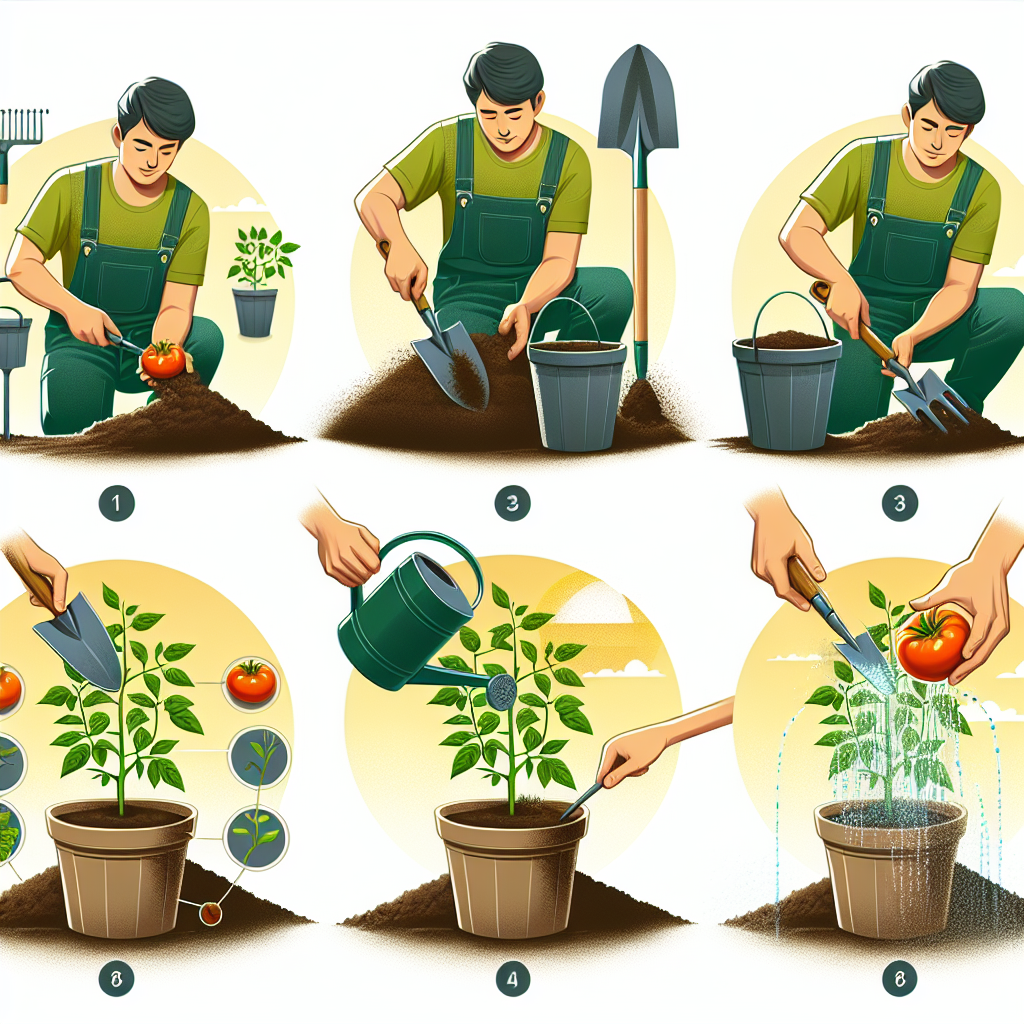
How to plant a tomato plant at home
Introduction to Home Gardening
Growing your own fruits and vegetables can be a rewarding and fulfilling experience. Among the many plants you can cultivate, tomatoes are one of the most popular choices. They are versatile, delicious, and can be easily grown at home. In this article, we will guide you through the essentials of how to plant a tomato plant at home, covering everything from selecting the right variety to caring for your plant as it grows.
Choosing the Right Variety of Tomato
Before you get started, it’s important to select a tomato variety that suits your taste preferences and growing conditions. Here are some popular varieties:
- Cherry Tomatoes: Small and sweet, perfect for snacking.
- Roma Tomatoes: Ideal for sauces and canning due to their fleshiness.
- Slicing Tomatoes: Great for sandwiches and salads.
Consider your climate as well. Some tomatoes grow better in cooler conditions, while others thrive in warmth. Research and choose a variety that fits your local growing zone.
Gathering Your Supplies
Once you’ve selected your tomato variety, it’s time to gather the necessary supplies for planting. Here’s a list to ensure you have everything:
- Tomato seeds or seedlings
- Quality potting soil
- Containers (if planting in pots)
- Watering can or hose
- Fertilizer (optional)
- Garden tools (shovel, rake, trowel)
- Mulch (optional)
Choosing the Right Location
Tomatoes require plenty of sunlight, so it’s crucial to find the right spot for your plants. Here are some tips for selecting a location:
- Look for a spot that receives at least 6-8 hours of direct sunlight each day.
- Ensure proper drainage to prevent waterlogging.
- Avoid areas with strong winds that could damage the plants.
Consider using containers if space is limited; they can be placed on patios, balconies, or small yards where sunlight is available.
Preparing the Soil
Healthy soil is vital for the growth of your tomato plant. Here’s how to prepare it:
- Choose a well-draining soil that is rich in organic matter.
- If using garden soil, mix in compost to enhance its nutrient content.
- Test the soil pH; tomatoes prefer a slightly acidic to neutral pH (between 6.0-7.0).
For container gardening, a good-quality potting mix will provide the right conditions for your tomato plant.
Planting Your Tomato Plant
Seedlings vs. Seeds
Depending on your preference and local climate, you can either start tomatoes from seeds or purchase young seedlings from a nursery. Here’s how to proceed:
- If using seeds:
- Start seeds indoors 6-8 weeks before the last frost date.
- Plant seeds about 1/4 inch deep in seed starting mixtures.
- Keep the soil moist and provide warmth to promote germination.
- If using seedlings:
- Select healthy, sturdy plants with dark green leaves.
- Dig a hole deep enough to bury the stem until the first set of leaves.
Transplanting Seedlings
Once your seedlings have grown to about 6-8 inches tall and the danger of frost has passed, they can be transplanted into their final growing place:
- Water the seedlings a day before transplanting.
- Dig a hole that is deep enough to accommodate the roots.
- Place the plant gently in the hole and fill it with soil, ensuring the stem is supported.
- Water thoroughly to help settle the soil.
Caring for Your Tomato Plant
Watering
Tomatoes require consistent watering. Here’s what you need to know:
- Water the plants deeply once or twice a week, depending on weather conditions.
- Avoid overhead watering to prevent diseases; water at the base of the plant.
- Mulch around the base to retain moisture and suppress weeds.
Fertilizing
Fertilizing can enhance growth, but it's important to do it correctly:
- Use a balanced fertilizer high in phosphorus for strong root growth.
- Fertilize every 4-6 weeks during the growing season.
- Don’t over-fertilize, as this can lead to excessive foliage with fewer fruits.
Pruning and Staking
To encourage healthy growth and better fruit yield, consider the following:
- Prune suckers (the small shoots in the leaf axils) to focus energy on fruiting branches.
- Stake or cage your tomato plants for support as they grow.
Proper staking helps prevent damage from wind and keeps the fruits off the ground.
Pest and Disease Management
Tomato plants can be susceptible to various pests and diseases. Here’s how to manage them:
- Regularly inspect plants for aphids, whiteflies, and hornworms.
- Use organic pest controls like neem oil or insecticidal soap when infestations occur.
- Rotate crops yearly to prevent soil-borne diseases and pests.
Harvesting Your Tomatoes
Once your tomato plant begins to bear fruit, it’s important to know when to harvest:
- Wait for tomatoes to turn a deep, rich color. For some varieties (like green tomatoes), this may be slightly different.
- Gently twist and pull the fruit to harvest—avoid tugging hard to prevent damage to the plant.
Conclusion
By following these guidelines, you’ll be well on your way to successfully growing your own delicious tomatoes. Remember, gardening is a learning process, and every year brings new challenges and rewards. Enjoy the journey and, most importantly, the fruits of your labor!
By Guest, Published on August 20th, 2024